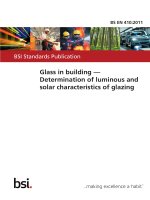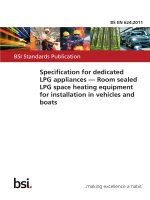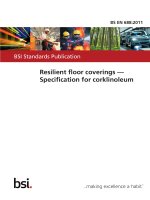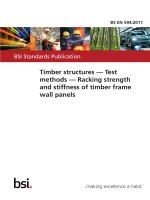Bsi bs en 62216 2011
Bạn đang xem bản rút gọn của tài liệu. Xem và tải ngay bản đầy đủ của tài liệu tại đây (2.14 MB, 144 trang )
BS EN 62216:2011
BSI Standards Publication
Digital terrestrial television
receivers for the DVB-T system
NO COPYING WITHOUT BSI PERMISSION EXCEPT AS PERMITTED BY COPYRIGHT LAW
raising standards worldwide™
BS EN 62216:2011
BRITISH STANDARD
National foreword
This British Standard is the UK implementation of EN 62216:2011. It is
identical to IEC 62216:2009. It supersedes BS EN 62216-1:2002 which is
withdrawn.
The UK participation in its preparation was entrusted to Technical
Committee EPL/100, Audio, video and multimedia systems and equipment.
A list of organizations represented on this committee can be obtained
on request to its secretary.
This publication does not purport to include all the necessary provisions
of a contract. Users are responsible for its correct application.
© BSI 2011
ISBN 978 0 580 64535 8
ICS 33.160.25
Compliance with a British Standard cannot confer immunity from
legal obligations.
This British Standard was published under the authority of the Standards
Policy and Strategy Committee on 31 July 2011.
Amendments issued since publication
Date
Text affected
BS EN 62216:2011
EUROPEAN STANDARD
EN 62216
NORME EUROPÉENNE
EUROPÄISCHE NORM
July 2011
ICS 33.160.25
Supersedes EN 62216-1:2002
English version
Digital terrestrial television receivers for the DVB-T system
(IEC 62216:2009)
Récepteur de télévision numérique
terrestre pour le système DVB-T
(CEI 62216:2009)
Fernsehempfänger für das digitale
terrestrische DVB-T-System
(IEC 62216:2009)
This European Standard was approved by CENELEC on 2011-01-02. CENELEC members are bound to comply
with the CEN/CENELEC Internal Regulations which stipulate the conditions for giving this European Standard
the status of a national standard without any alteration.
Up-to-date lists and bibliographical references concerning such national standards may be obtained on
application to the Central Secretariat or to any CENELEC member.
This European Standard exists in three official versions (English, French, German). A version in any other
language made by translation under the responsibility of a CENELEC member into its own language and notified
to the Central Secretariat has the same status as the official versions.
CENELEC members are the national electrotechnical committees of Austria, Belgium, Bulgaria, Croatia, Cyprus,
the Czech Republic, Denmark, Estonia, Finland, France, Germany, Greece, Hungary, Iceland, Ireland, Italy,
Latvia, Lithuania, Luxembourg, Malta, the Netherlands, Norway, Poland, Portugal, Romania, Slovakia, Slovenia,
Spain, Sweden, Switzerland and the United Kingdom.
CENELEC
European Committee for Electrotechnical Standardization
Comité Européen de Normalisation Electrotechnique
Europäisches Komitee für Elektrotechnische Normung
Management Centre: Avenue Marnix 17, B - 1000 Brussels
© 2011 CENELEC -
All rights of exploitation in any form and by any means reserved worldwide for CENELEC members.
Ref. No. EN 62216:2011 E
BS EN 62216:2011
EN 62216:2011
-2-
Foreword
The text of document 100/1449/CDV, future edition 1 of IEC 62216, prepared by technical area 1,
Terminals for audio, video and data services and contents of IEC TC 100, Audio, video and multimedia
systems and equipment, was submitted to the IEC-CENELEC parallel vote and was approved by
CENELEC as EN 62216 on 2011-01-02.
This European Standard supersedes EN 62216-1:2002.
Attention is drawn to the possibility that some of the elements of this document may be the subject of
patent rights. CEN and CENELEC shall not be held responsible for identifying any or all such patent
rights.
The following dates were fixed:
– latest date by which the EN has to be implemented
at national level by publication of an identical
national standard or by endorsement
(dop)
2011-10-02
– latest date by which the national standards conflicting
with the EN have to be withdrawn
(dow)
2014-01-02
Annex ZA has been added by CENELEC.
__________
Endorsement notice
The text of the International Standard IEC 62216:2009 was approved by CENELEC as a European
Standard without any modification.
__________
BS EN 62216:2011
-3-
EN 62216:2011
Annex ZA
(normative)
Normative references to international publications
with their corresponding European publications
The following referenced documents are indispensable for the application of this document. For dated
references, only the edition cited applies. For undated references, the latest edition of the referenced
document (including any amendments) applies.
NOTE When an international publication has been modified by common modifications, indicated by (mod), the relevant EN/HD
applies.
Publication
Year
Title
EN/HD
Year
-
-
Domestic and similar electronic equipment
interconnection requirements:
Peritelevision connector
EN 50049-1
-
-
-
Common interface specification for
conditional access and other digital video
broadcasting decoder applications
EN 50221
-
IEC 60958-1
-
Digital audio interface Part 1: General
EN 60958-1
-
IEC 61169-2
-
Radio-frequency connectors Part 2: Sectional specification - Radio
frequency coaxial connectors of type 9,52
EN 61169-2
-
IEC 61937
Series Digital audio - Interface for non-linear PCM
EN 61937
encoded audio bitstreams applying IEC 60958
ISO/IEC 6937
-
Information technology - Coded graphic
character set for text communication - Latin
alphabet
-
-
ISO/IEC 8859-9
-
Information technology - 8-bit single-byte
coded graphic character sets Part 9: Latin alphabet No. 5
-
-
ISO/IEC 11172-2
-
Information technology - Coding of moving
pictures and associated audio for digital
storage media at up to about 1,5 Mbit/s Part 2: Video
-
-
ISO/IEC 13818-1
-
Information technology - Generic coding of
moving pictures and associated audio
information: Systems
-
-
ISO/IEC 13818-2
-
Information technology - Generic coding of
moving pictures and associated audio
information Part 2: Video
-
-
ISO/IEC 13818-3
-
Information technology - Generic coding of
moving pictures and associated audio
information Part 3: Audio
-
-
ISO/IEC 14496-3
-
Information technology - Coding of audiovisual objects Part 3: Audio
-
-
ISO/IEC 14496-10
-
Information technology - Coding of audiovisual objects Part 10: Advanced Video Coding
-
-
Series
BS EN 62216:2011
EN 62216:2011
-4-
Publication
Year
Title
EN/HD
Year
ISO 639-2
-
Codes for the representation of names of
languages Part 2: Alpha-3 code
-
-
ETSI EN 300 744
-
Digital Video Broadcasting (DVB): Framing
structure, channel coding and modulation for
digital terrestrial television
-
ETSI EN 300 468
-
Digital Video Broadcasting (DVB):
Specification for Service Information (SI) in
DVB systems
-
-
ETS EN 300 743
-
Digital Video Broadcasting (DVB) - Subtitling systems
-
ETSI EN 300 706
-
Enhanced teletext specification
-
-
ETSI EN 300 472
-
Digital Video Broadcasting (DVB) Specification for conveying ITU-R system B
teletext in DVB bitstreams
-
-
ETSI EN 300 294
-
Television systems - 625 line television Wide Screen Signalling (WSS)
-
ETSI EN 301 775
-
Digital Video Broadcasting (DVB) Specification for the carriage of Vertical
Blanking Information (VBI) data in DVB
bitstreams
-
-
ETSI EN 300 231
-
Television systems - Specification of the
domestic video Programme Delivery Control
system (PDC)
-
-
ETSI TS 101 154
-
Digital Video Broadcasting
(DVB);Specification for the use of Video and
Audio Coding in Broadcasting Applications
based on the MPEG-2 Transport Stream
-
-
ETSI TS 102 366
-
Digital Audio Compression (AC-3, Enhanced AC-3)
-
ETSI TS 101 699
-
Digital Video Broadcasting (DVB) Extensions to the common interface
specification
-
-
ETSI TR 101 211
-
Digital Video Broadcasting (DVB); Guidelines on implementation and usage of Service
Information (SI)
-
ETSI TS 102 006
-
Digital Video Broadcasting
(DVB);Specification for System Software
Update in DVB Systems
-
-
ETR 289
-
Digital Video Broadcasting (DVB) Support for use of scrambling and Conditional
Access (CA) within digital broadcasting
systems
-
ETR 162
-
Digital broadcasting systems for television
sound and data services - Allocation of
Service Information (SI) codes for Digital
Video Broadcasting (DVB) systems
-
-
ITU-R BS.775-2
-
Multichannel stereophonic sound system with and without accompanying picture
-
ITU-R BT.470-7
-
Conventional analogue television systems
-
-
BS EN 62216:2011
-5-
EN 62216:2011
Publication
Year
Title
EN/HD
Year
ITU-R BT.1119-2
-
Wide-screen signalling for broadcasting
(Signalling for wide-screen and other
enhanced television parameters)
-
-
ITU-R BT.1359-1
-
Relative timing of sound and vision for
broadcasting
-
-
R 206-001
-
Guidelines for implementation and use of the common interface for DVB decoder
applications
-
CEA 770.3
-
High definition TV analog component video
interface
-
-
CEA 861
-
A DTV Profile for Uncompressed High Speed Digital Interfaces
-
BS EN 62216:2011
–2–
62216 IEC:2009(E)
CONTENTS
FOREWORD...........................................................................................................................8
INTRODUCTION................................................................................................................... 10
1
Scope and object............................................................................................................ 11
2
Normative references ..................................................................................................... 11
3
Abbreviations and symbols ............................................................................................. 13
4
Receiver capabilities ...................................................................................................... 15
5
4.1 Frequency spectrum .............................................................................................. 15
4.2 Conditional access ................................................................................................ 15
4.3 Return path ........................................................................................................... 15
4.4 EPG (SI) ............................................................................................................... 15
4.5 Auto installation..................................................................................................... 16
4.6 Teletext carried in digital streams .......................................................................... 16
4.7 Content protection/copy management.................................................................... 16
4.8 Services ................................................................................................................ 16
4.9 API ........................................................................................................................ 16
4.10 Over-air software update ....................................................................................... 16
4.11 Audio and video codecs ........................................................................................ 16
4.12 Future versions of this standard ............................................................................ 17
Video system characteristics .......................................................................................... 17
5.1
5.2
6
General ................................................................................................................. 17
Essential requirements .......................................................................................... 17
5.2.1 Standard services ...................................................................................... 17
5.2.2 Advanced services .................................................................................... 17
5.3 Constraints and extensions ................................................................................... 17
5.3.1 Support for rapid channel acquisition ......................................................... 17
5.3.2 Picture types ............................................................................................. 18
5.3.3 Compatibility.............................................................................................. 18
5.3.4 User data .................................................................................................. 19
5.3.5 Video alignment......................................................................................... 19
5.3.6 Chroma sampling location ......................................................................... 20
Video display formatting ................................................................................................. 21
6.1
6.2
6.3
6.4
6.5
General ................................................................................................................. 21
Video format.......................................................................................................... 21
6.2.1 General ..................................................................................................... 21
6.2.2 Requirements for DVB compliance ............................................................ 21
Recommendations for signalling in the video stream ............................................. 22
6.3.1 Sequence header ...................................................................................... 22
6.3.2 Sequence display extension ...................................................................... 22
6.3.3 Constraints on the use of the picture display extension ............................. 23
6.3.4 Format switching ....................................................................................... 23
Video format signalling extensions ........................................................................ 24
6.4.1 General ..................................................................................................... 24
6.4.2 MPEG signalling ........................................................................................ 24
6.4.3 DVB signalling ........................................................................................... 24
6.4.4 Active format description ........................................................................... 24
Recommendations for ISO/IEC 13818-1 signalling................................................. 32
BS EN 62216:2011
62216 IEC:2009(E)
–3–
6.6
7
Alignment of SD video and graphics ...................................................................... 32
6.6.1 Video with graphics ................................................................................... 32
6.6.2 Uncertainty of position of graphics over video............................................ 32
6.7 Alignment of HD video and graphics ...................................................................... 33
Audio system characteristics .......................................................................................... 33
7.1
7.2
8
General ................................................................................................................. 33
Essential requirements .......................................................................................... 33
7.2.1 Requirements ............................................................................................ 34
7.2.2 Synchronisation ......................................................................................... 34
7.2.3 Audio metadata ......................................................................................... 34
7.2.4 Decoding requirements .............................................................................. 34
7.3 Constraints and extensions ................................................................................... 35
7.3.1 Digitally coded ........................................................................................... 35
7.3.2 Surround sound ......................................................................................... 35
7.3.3 AC-3 and Enhanced AC-3 audio ................................................................ 35
7.3.4 ISO/IEC 14496-3 audio.............................................................................. 36
7.3.5 Receiver downmix ..................................................................................... 36
7.3.6 Digital audio output.................................................................................... 36
7.4 Audio description................................................................................................... 36
7.4.1 Background ............................................................................................... 36
7.4.2 Receiver implementation minima ............................................................... 37
7.4.3 Receiver mix AD signalling ........................................................................ 37
7.4.4 Constraints on audio description stream coding ......................................... 41
7.4.5 Receiver mix AD implementation notes ...................................................... 41
7.4.6 SI/PSI signalling ........................................................................................ 43
7.5 Audio only services ............................................................................................... 45
Multiplex and transport stream characteristics ................................................................ 45
8.1
8.2
9
Scope.................................................................................................................... 45
Essential requirements .......................................................................................... 45
8.2.1 Multiplexing ............................................................................................... 45
8.2.2 Demultiplexing ........................................................................................... 46
8.3 Constraints and extensions ................................................................................... 46
8.3.1 Multicomponent programs.......................................................................... 46
Service and program specific information ....................................................................... 47
9.1
9.2
General ................................................................................................................. 47
9.1.1 General requirements ................................................................................ 47
9.1.2 General receiver requirements .................................................................. 47
9.1.3 General broadcaster requirements............................................................. 48
9.1.4 Notation..................................................................................................... 49
SI and PSI specification ........................................................................................ 49
9.2.1 Summary ................................................................................................... 49
9.2.2 Program association table ......................................................................... 51
9.2.3 Program map table .................................................................................... 51
9.2.4 Conditional access table ............................................................................ 53
9.2.5 Network information table .......................................................................... 54
9.2.6 Bouquet association table.......................................................................... 56
9.2.7 Service description table ........................................................................... 56
9.2.8 Event information table .............................................................................. 59
9.2.9 Time and date table and time offset table .................................................. 62
BS EN 62216:2011
–4–
62216 IEC:2009(E)
9.2.10 Running status table .................................................................................. 62
9.2.11 Private data ............................................................................................... 62
9.2.12 Overview of service-variation options ........................................................ 68
9.3 Receiver functions................................................................................................. 69
9.3.1 Information typically available to the user .................................................. 69
9.3.2 Service change.......................................................................................... 69
9.3.3 Parental control ......................................................................................... 72
9.3.4 Receiver behaviour when a service stops .................................................. 72
9.4 Establishing and maintaining the network connection ............................................ 73
9.4.1 Use of SI identifiers ................................................................................... 73
9.4.2 Auto installation ......................................................................................... 74
9.4.3 Network evolution ...................................................................................... 76
9.4.4 Logical channel numbers (LCN) ................................................................. 78
9.4.5 Recommendation for robust SI acquisition ................................................. 82
9.5 User interface........................................................................................................ 84
9.5.1 Presentation of text ................................................................................... 84
9.5.2 Information presentation ............................................................................ 85
9.5.3 Service navigation ..................................................................................... 87
9.5.4 Display of time........................................................................................... 88
9.6 Recording devices ................................................................................................. 88
9.6.1 General ..................................................................................................... 88
9.6.2 Programming ............................................................................................. 88
9.6.3 Execution of recording ............................................................................... 88
9.6.4 Control of analogue recorders ................................................................... 89
10 Subtitles ......................................................................................................................... 89
10.1 General ................................................................................................................. 89
10.2 Broadcast specifications ........................................................................................ 89
10.2.1 DVB subtitles............................................................................................. 89
10.2.2 Signalling .................................................................................................. 90
10.2.3 DDS .......................................................................................................... 90
10.2.4 Recommendation....................................................................................... 90
10.3 Receiver functions................................................................................................. 90
10.3.1 Background ............................................................................................... 90
10.3.2 User control of receiver behaviour ............................................................. 91
10.3.3 Support for DDS ........................................................................................ 91
11 VBI based services ......................................................................................................... 91
11.1 General ................................................................................................................. 91
11.2 Broadcast specifications ........................................................................................ 91
11.3 Receiver functions................................................................................................. 92
11.3.1 Processing capabilities .............................................................................. 92
11.3.2 Control ...................................................................................................... 92
11.4 Extended VBI format support ................................................................................. 92
11.4.1 VPS ........................................................................................................... 93
11.4.2 WSS .......................................................................................................... 93
11.4.3 Teletext and teletext subtitles .................................................................... 93
12 RF-part and channel decoder ......................................................................................... 93
12.1 General ................................................................................................................. 93
12.2 Frequencies and channel bandwidth...................................................................... 93
12.3 DVB-T modes ........................................................................................................ 93
BS EN 62216:2011
62216 IEC:2009(E)
–5–
12.4
12.5
12.6
12.7
Tuning procedure .................................................................................................. 94
Change of modulation parameters ......................................................................... 94
Connector ............................................................................................................. 94
Performance.......................................................................................................... 94
12.7.1 Failure point criteria................................................................................... 94
12.7.2 C/N performance ....................................................................................... 94
12.7.3 Minimum receiver signal input levels ......................................................... 95
12.7.4 Maximum input level .................................................................................. 95
12.7.5 Immunity to analogue and/or digital signals in other channels.................... 95
12.7.6 Immunity to co-channel interference from analogue TV signals.................. 96
12.7.7 Guard interval utilisation in single frequency networks ............................... 97
12.7.8 MFN multipath performance....................................................................... 97
13 Conditional access and the common interface ................................................................ 98
13.1 General ................................................................................................................. 98
13.2 Minimum requirements .......................................................................................... 98
13.2.1 Analogue Copy Protection Resource ......................................................... 98
14 System software update ................................................................................................. 99
14.1 General ................................................................................................................. 99
14.2 Minimum requirements .......................................................................................... 99
14.3 Recommendations for SSU operators .................................................................... 99
15 Application Programming Interface (API) ........................................................................ 99
16 Connectors ................................................................................................................... 100
16.1 Standard receivers .............................................................................................. 100
16.2 Advanced receivers ............................................................................................. 100
16.2.1 Without display ........................................................................................ 100
16.2.2 With display............................................................................................. 101
Annex A (normative) SI character set................................................................................. 102
Annex B (normative) DVB-SI PDC descriptor ..................................................................... 111
Annex C (normative) Subtitling .......................................................................................... 113
Annex D (informative) An example of frequencies and offsets ............................................ 130
Annex E (informative) Noise model .................................................................................... 131
Annex F (informative) An example of C/N-performance with a practical transmitter ............ 132
Annex G (informative) Practical 6-path channel models for fixed and portable channels..... 133
Annex H (informative) Interfering analogue signals ............................................................ 134
Bibliography........................................................................................................................ 135
Figure 1 – Relationship between digital video and analogue video ........................................ 19
Figure 2 – Receiver and display format processing reference model ..................................... 26
Figure 3 – HD Receiver and display format processing reference model ............................... 27
Figure 4 – Uncertainty of positioning graphics over video...................................................... 33
Figure 5 – Illustration of control of audio level ....................................................................... 38
Figure 6 – Mapping of pan byte onto sound presentation ...................................................... 41
Figure 7 – Example of PMT extract for main programme audio ............................................. 44
Figure 8 – Example of PMT extract for audio description ...................................................... 44
Figure 9 – Service regionalisation ......................................................................................... 79
Figure C.1 – High level bitstream organisation .................................................................... 114
BS EN 62216:2011
–6–
62216 IEC:2009(E)
Figure C.2 – Region depth selection ................................................................................... 116
Figure C.3 – Mapping code strings to pixels in “requested” depth region ............................. 117
Figure C.4 – Mapping code strings to pixels........................................................................ 118
Figure C.5 – Subtitle reference decoder model ................................................................... 120
Figure C.6 – The two modelled decoding phases ................................................................ 121
Figure C.7 – Detail of data decoding phase ........................................................................ 122
Figure C.8 – Disruption to display at start of new epoch...................................................... 122
Figure E.1 – Tuner noise model .......................................................................................... 131
Figure H.1 – PAL interfering signals.................................................................................... 134
Figure H.2 – SECAM L interfering signal ............................................................................. 134
Table 1 – Broadcast overscan flags ...................................................................................... 20
Table 2 – Receiver overscan behaviour ................................................................................ 20
Table 3 – Overscan signalling on HDMI ................................................................................ 20
Table 4 – Horizontal scaling where format is signalled by the sequence header alone .......... 22
Table 5 – Pan scan window .................................................................................................. 23
Table 6 – Non “full screen”.................................................................................................... 23
Table 7 – Formats described by the active_format description .............................................. 25
Table 8 – Processing by STB connected to 4:3 TV................................................................ 28
Table 9 – User options for displaying 16:9 on 4:3.................................................................. 29
Table 10 – User options for displaying >16:9 on 4:3 .............................................................. 29
Table 11 – Processing by STB connected to 16:9 TV ............................................................ 30
Table 12 – WSS codes for aspect ratio ................................................................................. 31
Table 13 – Values for other WSS bits ................................................................................... 31
Table 14 – Audio description descriptor ................................................................................ 38
Table 15 – Illustration of PES packet header ........................................................................ 40
Table 16 – Key to symbols .................................................................................................... 49
Table 17 – Summary of required tables................................................................................. 50
Table 18 – Program descriptors ............................................................................................ 51
Table 19 – Elementary stream descriptors ............................................................................ 51
Table 20 – Network descriptors (first loop) ............................................................................ 54
Table 21 – Transport stream descriptors (second loop) ......................................................... 55
Table 22 – Service descriptors.............................................................................................. 57
Table 23 – Event information descriptors .............................................................................. 60
Table 24 – Time offset table descriptors ............................................................................... 62
Table 25 – Private SI recognised by this standard ................................................................ 63
Table 26 – Syntax of the eacem stream identifier descriptor ................................................. 63
Table 27 – Syntax of the logical channel descriptor .............................................................. 64
Table 28 – Logical channel number ...................................................................................... 65
Table 29 – Syntax of the preferred name list descriptor ........................................................ 65
Table 30 – Syntax of the preferred name identifier descriptor ............................................... 66
Table 31 – HD simulcast logical channel descriptor .............................................................. 67
Table 32 – Subtitle preference modes defined ...................................................................... 70
BS EN 62216:2011
62216 IEC:2009(E)
–7–
Table 33 – Receiver response to missing SI tables ............................................................... 83
Table 34 – Text field lengths ................................................................................................. 85
Table 35 – Delta values between picture failure point and reference BER ............................. 94
Table 36 – C/N (dB) for reference BER ................................................................................. 95
Table 37 – Immunity to analogue signals on other channels.................................................. 96
Table 38 – Immunity to digital signals on other channels ...................................................... 96
Table 39 – Immunity to co-channel interference from analogue signals ................................. 96
Table 40 – Long echo test profile .......................................................................................... 97
Table 41 – Short echo test profile ......................................................................................... 97
Table A.1 – Allowed character codes in SI text fields .......................................................... 103
Table B.1 – Syntax of the PDC descriptor ........................................................................... 111
Table C.1 – Additional display update budget for page/region operations............................ 123
Table C.2 – Example subtitle system performance .............................................................. 126
Table F.1 – C/N (dB) for reference BER .............................................................................. 132
Table G.1 – Approximate 6-tap channel for fixed reception (Ricean channel). ..................... 133
Table G.2 – Approximate 6-tap channel for portable reception (Rayleigh channel). ............. 133
BS EN 62216:2011
–8–
62216 IEC:2009(E)
INTERNATIONAL ELECTROTECHNICAL COMMISSION
____________
DIGITAL TERRESTRIAL TELEVISION RECEIVERS
FOR THE DVB-T SYSTEM
FOREWORD
1) The International Electrotechnical Commission (IEC) is a worldwide organization for standardization comprising
all national electrotechnical committees (IEC National Committees). The object of IEC is to promote
international co-operation on all questions concerning standardization in the electrical and electronic fields. To
this end and in addition to other activities, IEC publishes International Standards, Technical Specifications,
Technical Reports, Publicly Available Specifications (PAS) and Guides (hereafter referred to as “IEC
Publication(s)”). Their preparation is entrusted to technical committees; any IEC National Committee interested
in the subject dealt with may participate in this preparatory work. International, governmental and nongovernmental organizations liaising with the IEC also participate in this preparation. IEC collaborates closely
with the International Organization for Standardization (ISO) in accordance with conditions determined by
agreement between the two organizations.
2) The formal decisions or agreements of IEC on technical matters express, as nearly as possible, an international
consensus of opinion on the relevant subjects since each technical committee has representation from all
interested IEC National Committees.
3) IEC Publications have the form of recommendations for international use and are accepted by IEC National
Committees in that sense. While all reasonable efforts are made to ensure that the technical content of IEC
Publications is accurate, IEC cannot be held responsible for the way in which they are used or for any
misinterpretation by any end user.
4) In order to promote international uniformity, IEC National Committees undertake to apply IEC Publications
transparently to the maximum extent possible in their national and regional publications. Any divergence
between any IEC Publication and the corresponding national or regional publication shall be clearly indicated in
the latter.
5) IEC provides no marking procedure to indicate its approval and cannot be rendered responsible for any
equipment declared to be in conformity with an IEC Publication.
6) All users should ensure that they have the latest edition of this publication.
7) No liability shall attach to IEC or its directors, employees, servants or agents including individual experts and
members of its technical committees and IEC National Committees for any personal injury, property damage or
other damage of any nature whatsoever, whether direct or indirect, or for costs (including legal fees) and
expenses arising out of the publication, use of, or reliance upon, this IEC Publication or any other IEC
Publications.
8) Attention is drawn to the Normative references cited in this publication. Use of the referenced publications is
indispensable for the correct application of this publication.
9) Attention is drawn to the possibility that some of the elements of this IEC Publication may be the subject of
patent rights. IEC shall not be held responsible for identifying any or all such patent rights.
International Standard IEC 62216-1 has been prepared by technical area 1, Terminals for
audio, video and data services and contents, of IEC technical committee 100: Audio, video
and multimedia systems and equipment
The text of this standard is based on the following documents:
CDV
Report on voting
100/1449/CDV
100/1541/RVC
Full information on the voting for the approval of this standard can be found in the report on
voting indicated in the above table.
This publication has been drafted in accordance with the ISO/IEC Directives, Part 2.
BS EN 62216:2011
62216 IEC:2009(E)
–9–
The committee has decided that the contents of this publication will remain unchanged until
the maintenance result date indicated on the IEC web site under "" in
the data related to the specific publication. At this date, the publication will be
•
•
•
•
reconfirmed,
withdrawn,
replaced by a revised edition, or
amended.
A bilingual version of this publication may be issued at a later date.
BS EN 62216:2011
– 10 –
62216 IEC:2009(E)
INTRODUCTION
Television has evolved over the last half century from an up-market entertainment medium to
becoming the major information tool around the world. Television is available to virtually all
people around the globe, be it individually or in a community setting.
The advent of the “personal computer”, enabling global reach and instant interaction has
escalated the demand for more and more information and the ability to respond to it instantly.
It is thus that the broadcasters and content providers set out to seek new means of delivering
higher levels of content, be it in volume or quality using existing or new transport mechanisms
available.
Digitalisation, taken from the world of information technology was the obvious choice. It
further brought the added benefits of efficient use of spectrum and energy. Terrestrial
television has to migrate from analogue to digital in order to survive in the new information
society.
Governments are keen to switch off the inefficient analogue broadcasts for a number of
obvious reasons, but only will be able to do so when consumers are confident that the new
proposition is attractive and affordable.
Due to the multitude of communities, sometimes single operators, often on a country by
country basis dealing with the parameters and standards options of launching Digital
Terrestrial services based on DVB, there is a natural tendency to create a variety of
incompatible platforms tied to particular TV operators, and this in turn does not allow for
economy of scale for all parties concerned, be it content providers, broadcasters, network
providers or equipment manufacturers.
In 2000, after over two years of requirement capture in DigiTAG (Digital Television Action
Group) EACEM (European Association of Consumer Electronics Manufacturers), which has
evolved into EICTA (European Information, Communications and Consumer Electronics
Technology Industry Associations), decided to address this situation by developing a basic
specification as a minimum platform, providing secure reception of broadcast content and
associated services. This resulted in the first revision of this standard. It has been used as a
basis in many countries to deploy Digital Terrestrial TV (DTT) with great success.
In 2007, with a new wave of High Definition services being considered to be launched due to
the availability of MPEG4 components, EICTA and the French “Forum HD” decided to
collaborate to create an update for High Definition, and make some minor adjustments that
were due after 7 years of practice with Standard Definition terrestrial TV in the market. The
new standard improvements are taking into account contributions and comments from a.o. UK
DTG (draft HD D-Book), Nordig and DGTVi. This standard does not yet address new
generations of channel coding (DVB-T2) now being considered by DVB. Extensions of this
standard in this domain may be foreseen in the future.
BS EN 62216:2011
62216 IEC:2009(E)
– 11 –
DIGITAL TERRESTRIAL TELEVISION RECEIVERS
FOR THE DVB-T SYSTEM
1
Scope and object
This International Standard specifies both Standard Definition and High Definition receivers
for the DVB-T system.
It concerns:
•
broadcasters, and
•
receiver manufacturers.
The objective is to define:
•
how to provide broadcasts that are understood by all receivers and enable receivers to
provide good facilities to their users;
•
the behaviour required from receivers to work well with these broadcasts and to be
attractive to consumers.
To avoid doubt, the words “shall”, “should”, etc. are used in the traditional way to distinguish
issues that are mandatory versus those that are optional A baseline receiver will support the
mandatory features but not all the optional features in this standard. Inclusion of optional
features is part of the marketing strategy of the manufacturer.
Subtitling and teletext are considered to be components of TV services. Standalone teletext
services (without associated video content) are not part of this standard.
This standard primarily addresses terrestrial delivery of digital transmissions.
This standard primarily addresses deployment in countries that use European Latin script
based languages.
Two types of systems are considered:
•
standard systems where services are all SD and use well-established codecs. Standard
receivers which can decode standard services are suitable for these systems;
•
advanced systems where some services may use advanced codecs, for example to
provide HD video. Advanced receivers which can decode advanced services are suitable
for these systems.
Where the term “receiver” or “broadcast” is used without a qualifier, the statement is
applicable equally to both types of systems.
2
Normative references
The following referenced documents are indispensable for the application of this document.
For dated references, only the edition cited applies. For undated references, the latest edition
of the referenced document (including any amendments) applies.
IEC 61169-2, Radio-frequency connectors – Part 2: Sectional specification – Radio frequency
coaxial connectors of type 9,52
BS EN 62216:2011
– 12 –
62216 IEC:2009(E)
IEC 60958-1, Digital audio interface – Part 1: General
IEC 61937 (all parts), Digital audio – Interface for non-linear PCM encoded audio bitstreams
applying IEC 60958
ISO/IEC 6937, Information technology – Coded graphic character set for text communication –
Latin alphabet
ISO/IEC 8859-9, Information technology – 8-bit single-byte coded graphic character sets –
Part 9: Latin alphabet No. 5
ISO/IEC 11172-2, Information technology – Coding of moving pictures and associated audio
for digital storage media at up to about 1,5 Mbit/s – Part 2: Video
ISO/IEC 13818-1, Information technology – Generic coding of moving pictures and associated
audio information: Systems
ISO/IEC 13818-2, Information technology – Generic coding of moving pictures and associated
audio information: Video
ISO/IEC 13818-3, Information technology – Generic coding of moving pictures and associated
audio information: Audio
ISO/IEC 14496-3, Information Technology – Coding of audio-visual objects –Part 3: Audio
ISO/IEC 14496-10, Information technology – Coding of audio-visual objects – Part 10:
Advanced Video Coding
ISO 639-2, Codes for the representation of names of languages – Part 2: Alpha-3 code
ITU-R BS.775-2, Multichannel stereophonic sound system with and without accompanying
picture
ITU-R BT.470-7 Conventional television systems
ITU-R BT.1119-2, Wide-screen signalling for broadcasting (Signalling for wide-screen and
other enhanced television parameters)
ITU-R BT.1359-1, Relative timing of sound and vision for broadcasting
EN 50049-1, Domestic and similar electronic equipment interconnection requirements:
Peritelevision connector
EN 50221, Common Interface Specification for Conditional Access and Other Digital Video
Broadcasting Decoder Applications
EN 300 294, Television Systems – 625-line television Wide Screen Signalling (WSS)
EN 300 468, Digital Video Broadcasting (DVB) – Specification for Service Information (SI) in
DVB systems
EN 300 472, Digital Video Broadcasting (DVB) – Specification for conveying ITU-R System B
Teletext in DVB bitstreams
EN 300 743, Digital Video Broadcasting (DVB) – Subtitling systems
BS EN 62216:2011
62216 IEC:2009(E)
– 13 –
EN 300 744, Digital Video Broadcasting (DVB) – Framing structure, channel coding and
modulation for digital terrestrial television
EN 301 775, Digital Video Broadcasting (DVB) – Specification for the carriage of Vertical
Blanking Information (VBI) data in DVB bitstreams
ETR 162, Digital broadcasting systems for television sound and data services; Allocation of
Service Information (SI) codes for Digital Video Broadcasting (DVB) systems
Note that the allocation of identifiers is handled by DVB; up-to-date information on DVB identifiers can be obtained
from <www.dvb.org>.
ETR 289, Digital Video Broadcasting (DVB) – Support for use of scrambling and Conditional
Access (CA) within digital broadcasting systems
ETS 300 231, Television systems; Specification of the domestic video Programme Delivery
Control system (PDC)
ETS 300 706, Enhanced Teletext specification
R206-001, Guidelines for Implementation and Use of the Common Interface for DVB Decoder
Applications
TS 101 154, Digital Video Broadcasting (DVB); Implementation guidelines for the use of Video
and Audio Coding in Broadcasting Applications based on the MPEG-2 Transport Stream
TR 101 211, Digital Video Broadcasting (DVB); Guidelines on implementation and usage of
Service Information (SI)
TS 101 699, Digital Video Broadcasting (DVB); Extensions to the Common Interface
Specification
TS 102 006, Digital Video Broadcast (DVB); Specification for System Software Update in DVB
systems
TS 102 366, Digital Audio Compression (AC-3, Enhanced AC-3) Standard
CEA 770.3, High Definition TV Analog Component Video Interface
CEA 861, A DTV Profile for Uncompressed High Speed Digital Interfaces
3
Abbreviations and symbols
AD
Audio Description
AFD
Active Format Description
API
Application Programming Interface
AU
Access Unit
BAT
Bouquet Association Table
bslbf
Bit string, left bit first
CA
Conditional Access
CCO
Centre Cut-Out
DDS
Display Definition Segment
BS EN 62216:2011
– 14 –
DTS
Digital Theatre System
DTT
Digital Terrestrial Television
DVB
Digital Video Broadcast
EBU
European Broadcast Union
EIT
Event Information Table
EITpf
EIT present/following
EPG
Electronic Programme Guide
FF
Full Frame
IDTV
Integrated Digital Television
IPPV
Impulse Pay Per View
HD
High Definition
HDCP
High-bandwidth Digital Content Protection
HDMI™ 1
High Definition Multimedia Interface™
LB
Letter Box
LCN
Logical Channel Number
MFN
Multi Frequency Network
MTBF
Mean Time Between Failure
NIT
Network Information Table
NVOD
Near Video On Demand
PCS
Page Composition Segment
PDC
Programme Delivery Control
PES
Packetised Elementary Stream
PIL
Programme Identification Label
PMT
Program Map Table
PSI
Program Specific Information
PTS
Presentation Time Stamp
RNIB
Royal National Institute for the Blind
RST
Running Status Table
SD
Standard Definition
SDT
Service Description Table
SFN
Single Frequency Network
SI
Service Information
SSU
System Software Update
STB
Set Top Box
TDT
Time and Date Table
TOT
Time Offset Table
TS
Transport Stream
62216 IEC:2009(E)
———————
1
HDMI and High-Definition Multimedia Interface are trade marks of the HDMI Licensing, LLC. This information is
given for the convenience of users of this document and does not constitute an endorsement by IEC of the
product named.
BS EN 62216:2011
62216 IEC:2009(E)
– 15 –
UCS
Universal Character Set
uimsbf
Unsigned integer most significant bit first
UNT
Update Notification Table
UTC
Universal Time, Co-ordinated
VUI
Video Usability Information
VCR
Video Cassette Recorder
VPS
Video Programming System
WSS
Wide Screen Signalling
4
4.1
Receiver capabilities
Frequency spectrum
The receiver shall support:
•
UHF and/or VHF (band III);
•
8 MHz and/or 7 MHz channel bandwidth;
•
all DVB-T modulation methods;
•
both 2K and 8K transmitting methods;
•
all code rates;
•
all guard intervals;
•
hierarchical mode by the demodulator (optional);
•
frequency offset management;
•
multi-frequency networks (MFNs) and single frequency networks (SFNs);
•
support DVB-H service discrimination.
4.2
Conditional access
The receiver is capable of receiving free-to-air services and is recommended to provide
access to scrambled services. In order to have the needed flexibility to choose a Conditional
Access (CA) system one Common Interface slot (according to EN 50221) is foreseen. In the
future other means to add new CA systems might be used instead.
4.3
Return path
If a modem is not embedded then suitable means should be provided for connection to one
(for example RS 232) or to the internet for further interactive applications (for example IPPV).
4.4
EPG (SI)
The electronic programme guide (EPG) shall use the mandatory service information broadcast
in the service information table and the event information table to present appropriate service
and event information to the user and to allow automatic selection of service features when
the user selects a service.
Details can be found in Clause 9, which is based on (mandatory) DVB-SI rules.
BS EN 62216:2011
– 16 –
4.5
62216 IEC:2009(E)
Auto installation
The receiver shall allow access to all receivable services and will use the mandatory
information in the NIT and/or SDT to automate the initialisation of the service list and
subsequent updates thereof. See also 9.4.2.
4.6
Teletext carried in digital streams
Support of this feature is the responsibility of the manufacturer. Manufacturers are prepared
to support teletext for a transition period. This feature and its signalling is described in Clause
11. In order to allow for future phase-out, DVB-subtitle decoding is the recommended
transmission format for subtitling.
4.7
Content protection/copy management
Analogue recording via the peritelevision connector (EN 50049-1) is supported.
Digital content protection using HDCP on the HDMI output connector should be supported on
receivers without integrated video display.
4.8
Services
The receiver shall support the following services and service features:
•
free to air broadcast;
•
multi-lingual sound;
•
multi-lingual subtitles (DVB subtitles);
•
audio broadcast;
•
screen formatting for ratios of 4:3 and 16:9;
•
content rating protection based on DVB standard (see 9.2.8.1.7 and 9.3.3).
In addition, the receiver may support:
•
teletext linked with a program;
•
mosaic services;
•
Automatic Format Descriptor (AFD) for flexible screen formatting.
4.9
API
The receiver may support an API in order to facilitate interactive TV services. See Clause 15.
4.10
Over-air software update
The receiver may support the DVB System Software Update service in order to permit
maintenance or functional upgrades once the receiver is deployed in the field. See Clause 14.
4.11
Audio and video codecs
A standard receiver shall at least support MPEG-2 audio and SD video.
An advanced receiver shall, in addition, support:
•
ISO/IEC 14496-10 SD and HD video, as specified in TS 101 154;
•
either ISO/IEC 14496-3 HE-AAC audio (v1 only, i.e. not including the Parametric Stereo
tool) or TS 102 366 Enhanced AC-3 audio, as specified in TS 101 154;
BS EN 62216:2011
62216 IEC:2009(E)
•
– 17 –
multi-channel audio, encoded using one of the codecs in the previous bullet, up to 5.1
channels.
4.12
Future versions of this standard
It is the intention to extend this standard in a backward compatible way towards new types of
services and service options and consequent receiver behaviour.
5
Video system characteristics
5.1
General
This clause defines the digital video encoding standards that shall be used.
It is based on the D-Book version 3.0.
5.2
5.2.1
Essential requirements
Standard services
Broadcast video shall be encoded according to ISO/IEC 13818-2 constrained according to TS
101 154. All receivers should be able to meet the minimum decoding requirements set out
in TS 101 154.
Only the ‘25 Hz MPEG-2 SDTV’ variant described in the ‘Video’ clause of TS 101 154 is
relevant to this standard.
5.2.2
Advanced services
Broadcast video shall be encoded according to ISO/IEC 14496-10 (H.264/AVC) constrained
according to TS 101 154. All advanced receivers should be able to meet the minimum
decoding requirements set out in TS 101 154.
Only the ‘25 Hz H.264/AVC SDTV’ and ‘25 Hz H.264/AVC HDTV’ variants (plus the Common
parts) described in the ‘Video’ clause of TS 101 154 are relevant to this standard.
5.3
Constraints and extensions
This clause sets out the additional requirements on the broadcast signals and reception
equipment in addition to the DVB requirements in TS 101 154.
5.3.1
Support for rapid channel acquisition
To reduce the typical time taken to start decoding a new service, each video elementary
stream carrying ISO/IEC 13818-2 encoded video shall contain a sequence header and
associated group of pictures header at an interval no greater than 0,5 s. Also, each such
sequence header shall be immediately preceded by a PES packet header carrying a PTS 2.
For video encoded to ISO/IEC 14496-10, random access points shall be inserted at an
interval no greater than 2 s and should be inserted at an interval no greater than 0,5 s where
channel change speed is important.
Receivers should still be able to decode the video elementary stream when these figures are
exceeded.
———————
2
TS 101 154 recommends but does not mandate this.
BS EN 62216:2011
– 18 –
62216 IEC:2009(E)
There is no requirement to set the data alignment indicator flag in the PES packet header or
for the broadcast to include a data stream alignment descriptor associated with the video
elementary stream in the PMT. If a data stream alignment descriptor is included for a video
elementary stream then it shall indicate alignment type ‘04’.
5.3.2
Picture types
Beyond the requirements of ISO/IEC 13818-2 and the requirement for periodic I pictures
implied by 5.3.1, no additional constraints are placed on the sequence of coded picture types.
Specifically, no additional constraints are placed on the number of B pictures between I and P
pictures. As required by the main profile of ISO/IEC 13818-2, broadcasts may use I, P, B and
dual-prime frame types.
Advanced services encoded to ISO/IEC 14496-10 shall follow the restrictions of picture and
slice types set out in TS 101 154.
5.3.3
5.3.3.1
Compatibility
ISO/IEC 11172-2 compatibility
TS 101 154 requires that video encoding shall conform to the ISO/IEC 13818-2 main profile at
main level. This requires support for ISO/IEC 11172-2 ‘D’ pictures and “constrained
parameters” video.
Broadcasts conforming to this standard shall not include ISO/IEC 11172-2 ‘D’ pictures or
sequences with a horizontal_size greater than 720.
5.3.3.2
5.3.3.2.1
ISO/IEC 14496-10 compatibility
Standard definition
Standard definition video services shall be encoded according to TS 101 154 except that High
Profile may be used in markets where HD services are also broadcast. This means that
receivers shall support video encoding up to ISO/IEC 14496-10 High Profile level 3.
Receiver’s support other profiles beyond High Profile is optional. Support of levels beyond
level 3 is optional. If the receiver encounters an extension which it cannot decode, it shall
discard the following data until the next start code prefix (to allow backward compatible
extensions to be added in the future).
Broadcasts conforming to this standard shall not include sequences with a horizontal_size
greater than 720.
5.3.3.2.2
High definition
TS 101 154 requires that high definition video encoding shall conform to ISO/IEC 14496-10
High Profile level 4. Receiver’s support for profiles other than High Profile or levels outside
the range 3.0 to 4.0 is optional. If the receiver encounters an extension which it cannot
decode, it shall discard the following data until the next start code prefix (to allow backward
compatible extensions to be added in the future).
Broadcasts conforming to this standard shall not include sequences with a horizontal_size
greater than 1920.
5.3.3.2.3
Still pictures
Advanced receivers shall support the decoding and display of still pictures for all AVC profiles.
To signal a video stream containing still pictures, the broadcast shall set the
AVC_still_present flag in the AVC descriptor, as specified in ISO/IEC 13818-1. The receiver
BS EN 62216:2011
62216 IEC:2009(E)
– 19 –
shall decode the still picture frame and repeat displaying it until the subsequent (still picture)
frame is available to display.
NOTE
Broadcasts containing still pictures are typically at very low frame rates (for example 1 frame per second).
5.3.4
User data
To ensure good functionality in current and future receiver video decoder implementations, a
buffer model for user data within the video elementary stream is defined. The currently
proposed use for this is to carry the “active format description” described in 6.4.4. This only
exploits a small number of the bytes that might be used. Broadcasts are not required to carry
this data.
If user data is carried, it shall meet the following buffer model:
•
all user data bytes enter a single buffer of size 16 bytes (the user data start code is
discarded before data is delivered to the buffer);
•
all the data delivered at one time is removed from the buffer no later than 40 ms after it
was delivered.
5.3.5
Video alignment
5.3.5.1
Analogue SD output signal
64 μs
Analogue vidéo
output
10,5 μs min.
1,5 µs
Active video
132p
Digital vidéo
output
720p
12p
Active pixels
p = periods of luminance pixel clock
IEC 2257/01
Figure 1 – Relationship between digital video and analogue video
The digital video output of the receiver’s video decoder and graphics display system domain
contains 720 active pixels per line; these shall be aligned to the SD analogue video output
signal as shown in Figure 1.
It should be noted that:
•
at least the first 9 and the last 9 of the 720 video pixels should be replaced with a blanking
level to ensure compliance with ITU-R BT.470-7;
•
optionally, additional blanking may be applied to the start and end of the active video,
suppressing further active pixels;
•
the position of the first of the 720 active video pixels corresponds to 132 pixel periods
(≈9,8 μs) after the falling edge of line sync;
•
the figure is specific for PAL output signals. For receivers with SECAM output signals,
similar positioning and blanking shall be done.
5.3.5.2
Overscan
Typically a 5 % border region inside each edge of the 702 × 576 pixel area is not visible due
to overscan on a display.









